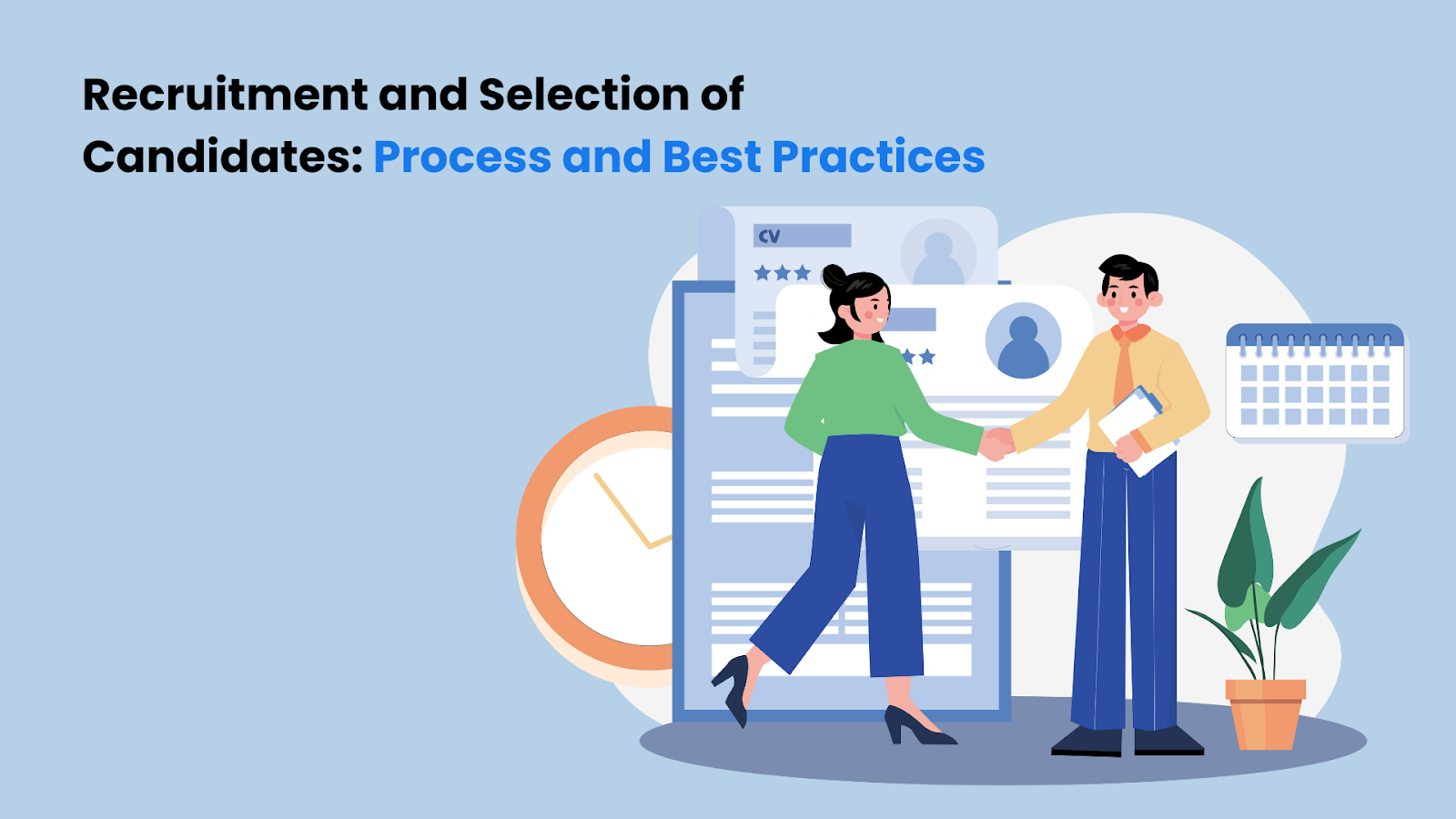Did you know a bad hire can cost your company up to 30% of that employee's first-year earnings? This statistic underscores the significant financial impact of ineffective recruitment.
Recruitment of candidates is more than just filling open positions. It’s about attracting, assessing, and selecting the right talent to align with your organization's goals and culture. This process, when optimized, creates a solid foundation for long-term success and competitiveness in today’s fast-paced business environment.
A well-executed recruitment process ensures you don’t just hire people. You hire the right people.
In this blog, we’ll explore the step-by-step process of recruiting and selecting candidates while highlighting best practices to make your hiring strategy more effective.
First, let's define recruitment and selection.
What is Recruitment and Selection of Candidates?
Recruitment and selection are fundamental human resource processes that organizations use to identify, attract, and choose individuals to fill job vacancies.
- Recruitment involves generating a pool of qualified candidates through various methods such as job postings, referrals, and headhunting.
- Selection refers to the process of evaluating and choosing the most suitable candidate from the pool of applicants.
Together, these processes ensure that organizations acquire the talent necessary to achieve their objectives and maintain a competitive edge.
Now, let’s explore the importance of effective recruitment and selection!
Importance of Effective Recruitment and Selection
The recruitment of candidates is more than just filling vacancies. It's about finding individuals who align with the organization's values, culture, and goals. Here's why effective recruitment and selection are crucial:
- Enhances Organizational Performance: Hiring the right people leads to higher productivity, better performance, and increased profitability.
- Reduces Turnover: Effective selection processes ensure that new hires are a good fit, reducing the likelihood of early turnover and the associated costs.
- Builds a Strong Employer Brand: A positive recruitment experience can enhance an organization's reputation, making it more attractive to top talent.
- Fosters Diversity and Inclusion: Strategic recruitment practices promote a diverse workforce, bringing varied perspectives and ideas.
- Ensures Legal Compliance: Proper recruitment and selection processes help organizations adhere to labor laws and avoid potential legal issues.
With a clear understanding of its importance, let's explore the steps involved.
Steps in the Recruitment and Selection Process
A well-structured recruitment and selection process ensures that organizations systematically identify and hire the best candidates. Here are the essential steps involved:
1. Identifying the Need
The first step is recognizing the need for a new hire, whether it's to fill a vacancy or create a new position. This involves:
- Analyzing Workloads: Assessing current workloads to determine if additional staff is required.
- Forecasting Future Needs: Anticipating future growth or changes that might necessitate new roles.
Having identified the need, the next step is clearly defining the role.
2. Job Analysis and Description
Understanding the role is crucial for attracting the right candidates.
- Job Analysis: Gathering information about the duties, responsibilities, and necessary skills.
- Job Description: Creating a clear and detailed description outlining the role, responsibilities, required qualifications, and preferred attributes.
With a well-defined job description, you can effectively source candidates.
3. Sourcing Candidates
Attracting a pool of qualified candidates through various channels:
- Job Postings: Advertising on job boards, company websites, and social media platforms.
- Employee Referrals: Encouraging current employees to refer potential candidates.
- Recruitment Agencies: Partnering with agencies to reach a broader audience.
- Campus Recruitment: Engaging with universities and colleges to attract fresh talent.
Once you have a pool of candidates, it's time to screen and shortlist them.
4. Screening and Shortlisting
Filtering applications to identify candidates who meet the minimum qualifications.
- Resume Screening: Reviewing resumes to assess qualifications and experience.
- Initial Assessments: Conducting phone interviews or online assessments to evaluate candidates further.
- Shortlisting: Selecting a manageable number of candidates for the next stage.
After shortlisting, the interview process begins.
5. Interviewing
Evaluating candidates through structured interviews to assess their fit for the role and organization.
- Behavioral Interviews: Assessing past behavior as an indicator of future performance.
- Technical Interviews: Testing specific skills and knowledge relevant to the job.
- Panel Interviews: Involving multiple interviewers to gain diverse perspectives.
Following interviews, the selection of the best candidate takes place.
6. Selection
Choosing the most suitable candidate based on the evaluation criteria.
- Reference Checks: Verifying the candidate's work history and qualifications.
- Background Checks: Ensuring the candidate meets all legal and organizational requirements.
- Decision Making: Selecting the candidate who best fits the role and organizational culture.
Once selected, it's essential to integrate the new hire smoothly.
7. Onboarding
Integrating the new hire into the organization to ensure a smooth transition.
- Orientation Programs: Introducing the new employee to company policies, culture, and team members.
- Training: Providing necessary training to equip the new hire with the skills required for the role.
- Mentorship: Assigning a mentor to support the new employee's development and integration.
Now that we've covered the steps, let's look at some best practices.
Best Practices in Recruitment of Candidates
To optimize the recruitment of candidates, organizations should adopt the following best practices:
1. Develop a Strong Employer Brand
A compelling employer brand attracts top talent. Highlight your organization's values, culture, and benefits through:
- Consistent Messaging: Ensure your brand message is consistent across all platforms.
- Employee Testimonials: Share stories and experiences from current employees.
- Showcase Achievements: Highlight awards, recognitions, and milestones.
2. Leverage Technology
Utilize technology to streamline the recruitment process and enhance candidate experience.
- Applicant Tracking Systems (ATS): Manage applications efficiently and track candidate progress.
- AI and Automation: Use AI tools for resume screening, chatbots for initial interactions, and automated scheduling.
- Data Analytics: Analyze recruitment data to identify trends and improve strategies.
3. Implement Structured Interview Processes
Structured interviews ensure fairness and consistency in evaluating candidates.
- Standardized Questions: Use the same set of questions for all candidates to compare responses effectively.
- Clear Evaluation Criteria: Define the criteria for assessment before conducting interviews.
- Training Interviewers: Equip interviewers with the skills to conduct effective and unbiased interviews.
4. Focus on Diversity and Inclusion
Promote a diverse and inclusive workforce by:
- Inclusive Job Descriptions: Use language that appeals to a broad audience.
- Diverse Sourcing Channels: Reach out to diverse communities and networks.
- Bias Training: Educate hiring teams to recognize and mitigate unconscious biases.
5. Provide a Positive Candidate Experience
A positive recruitment experience enhances your employer brand and attracts quality candidates.
- Clear Communication: Keep candidates informed throughout the process.
- Timely Feedback: Provide constructive feedback promptly.
- Respect and Professionalism: Treat all candidates with respect, regardless of the outcome.
6. Continuously Improve Your Recruitment Strategy
Regularly assess and refine your recruitment processes to ensure effectiveness.
- Gather Feedback: Collect feedback from candidates and hiring teams.
- Analyze Metrics: Track key performance indicators such as time-to-hire, cost-per-hire, and quality of hire.
- Adapt to Trends: Stay updated with the latest recruitment trends and technologies.
Even with best practices, challenges may arise. Let's address some common ones.
Common Challenges in Recruitment
Recruitment and selection can present several challenges for organizations. Here are some of the most common obstacles:
1. Talent Shortage
Finding qualified candidates for specialized roles can be difficult, leading to prolonged vacancies and increased workloads for existing staff.
2. High Turnover Rates
High employee turnover can be costly and disrupt team dynamics, often resulting from poor hiring decisions or lack of employee engagement.
3. Unconscious Bias
Bias in the recruitment process can lead to a lack of diversity and prevent the selection of the best candidates based on merit.
4. Long Time-to-Hire
A lengthy hiring process can result in lost candidates to other opportunities and increased costs associated with prolonged vacancies.
5. Inconsistent Recruitment Processes
Lack of standardization in recruitment can lead to inefficiencies and inconsistencies in candidate evaluation and selection.
Addressing these challenges requires innovative tools and strategies customized to modern recruitment needs.
How Tidy Hire helps to overcome these challenges
Tidy Hire offers innovative solutions to overcome these recruitment challenges effectively:
- Extensive Candidate Sourcing: TidyHire's AI-powered Recruiting Intelligence Agent (RIA) accesses over 700 million profiles across 30+ platforms, enabling recruiters to tap into a vast pool of potential candidates efficiently.
- Personalized Outreach and Engagement: TidyHire automates and personalizes communication with candidates across multiple channels, such as email, LinkedIn, WhatsApp, and SMS, ensuring candidates feel valued and engaged throughout the hiring process.
- AI-Driven Candidate Matching: TidyHire's AI algorithms focus on objective criteria, such as skills and experience, reducing the influence of unconscious bias in candidate selection.
- Automated Sourcing and Screening: TidyHire automates time-consuming tasks like candidate sourcing and follow-ups, allowing recruiters to focus on high-level decision-making and reducing time-to-hire.
- Seamless Integration and Collaboration: TidyHire integrates with internal communication platforms like Slack and MS Teams, ensuring a standardized and efficient recruitment process.
Organizations can overcome these common challenges by leveraging TidyHire's comprehensive recruitment solutions, leading to a more efficient and effective hiring process.
Beyond solving current challenges, it’s crucial to stay ahead by embracing the future trends shaping recruitment.
Future Trends in Recruitment and Selection
The recruitment of candidates is continuously evolving. Here are some trends to
1. Artificial Intelligence and Automation: AI will play a larger role in automating repetitive tasks, enhancing candidate matching, and providing data-driven insights.
2. Remote Recruitment: With the rise of remote work, recruitment strategies will increasingly focus on sourcing and onboarding remote talent.
3. Enhanced Candidate Experience: Organizations will prioritize creating seamless and engaging experiences to attract and retain top candidates.
4. Data-Driven Hiring: Leveraging big data and analytics to make informed hiring decisions and predict candidate success.
5. Focus on Soft Skills: Beyond technical abilities, employers will emphasize soft skills such as adaptability, communication, and problem-solving.
Emerging technologies and shifting workplace dynamics transform how organizations attract and retain talent.
Conclusion
In conclusion, the recruitment and selection of candidates are pivotal processes that shape the future of any organization. By understanding their importance, following a structured process, and adopting best practices, businesses can attract and retain the talent necessary for sustained success.
Tidy Hire serves as a valuable partner in the recruitment process, providing solutions that tackle common hiring challenges, improve operational efficiency, and facilitate the selection of the most suitable candidates.
Ready to transform your hiring strategy? Contact Tidy Hire today and take the first step towards building a stronger, more dynamic workforce for your organization.


